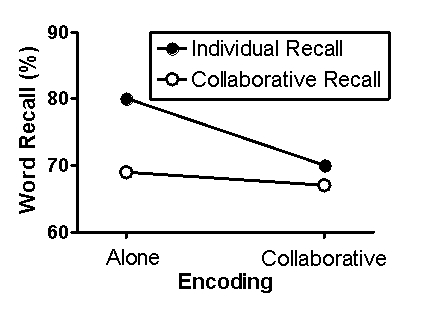Use the following to answer questions :
Scenario I
The scenario is based on and presents fabricated data consistent with the following study:
Barber,S.J. ,Rajaram,S. ,& Fox,E.B.(2012) .Learning and remembering with others: The key role of retrieval in shaping group recall and collective memory.Social Cognition,30(1) ,121-132.doi:10.1521/soco.2012.30.1.121
In a typical experiment on collaborative memory,participants first encode information individually and later attempt to recall the information either individually or in a small group (collaboratively) .While the recall of the collaborative group is better than that of any individual,the summed recall of individuals typically is better than the recall of the collaborative group.This is a phenomenon termed collaborative inhibition.Barber,Rajaram,and Fox (2012) investigated this phenomenon during both the encoding and retrieval stages of memory.
Participants created sentences out of a word bank,which provided for the opportunity to encode this information.After completing this task,participants engaged in an unrelated task-solving mazes-for 10 minutes.Then,in a surprise memory test,they were asked to recall as many words from the word bank as possible (retrieval) .
Participants were randomly assigned to one of four groups.In the first group (Alone-Alone) ,participants were studied individually during both the encoding and retrieval phases of the experiment.In the second group (Alone-Collaborative) ,participants were studied individually during the encoding phase and as part of a three-member team (triad) during the retrieval phase.In the third group (Collaborative-Alone) ,participants were studied in a triad during the encoding phase but individually during the retrieval phase.Finally,in the fourth group (Collaborative-Collaborative) ,participants completed both phases of the experiment as part of a triad.
Fabricated results illustrating the major finding of Barber et al.(2012) are presented in Figure 6.1.This figure shows the percentage of words from the word bank accurately recalled as a function of group.For the two groups that experienced the retrieval phase individually,scores represent the summed retrieval of the individuals comprising the group.For the two groups that experienced the retrieval phase as part of a triad,scores simply represent the collaborative performance.
Figure 6.1 
-(Scenario I) Some degree of collaborative inhibition was observed:
Definitions:
Right-sided Hemiplegia
Paralysis or severe weakness affecting the right side of the body, often resulting from a brain injury or stroke.
Impaired Transfer Ability
A condition where an individual has difficulty moving from one position or place to another.
Repositioning Patient
The act of adjusting a patient's position in bed or in a chair to promote comfort and prevent complications from immobility.
Abdominal Muscles
A group of muscles in the stomach area that support the trunk, allow movement, and hold organs in place by regulating internal abdominal pressure.
Q5: When asked to remember their grades in
Q75: _ is the process of maintaining information
Q76: A process by which retrieving an item
Q94: Which statement BEST describes a benefit of
Q264: While dreaming,we usually accept the contents of
Q317: William James conducted the Little Albert study.
Q332: Storing information by converting it into mental
Q372: People usually do not report mind wandering
Q390: According to Freud,the latent content of our
Q408: Jessica has problems concentrating and,as such,does not